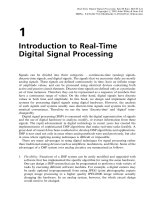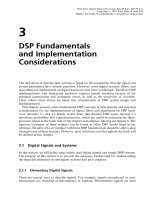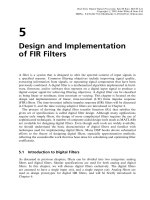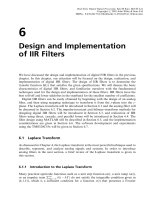Real-Time Digital Signal Processing - Chapter 7: Fast Fourier Transform and Its Applications
Bạn đang xem bản rút gọn của tài liệu. Xem và tải ngay bản đầy đủ của tài liệu tại đây (274.2 KB, 47 trang )
7
Fast Fourier Transform and Its
Applications
Frequency analysis of digital signals and systems was discussed in Chapter 4. To per-
form frequency analysis on a discrete-time signal, we converted the time-domain
sequence into the frequency-domain representation using the z-transform, the
discrete-time Fourier transform (DTFT), or the discrete Fourier transform (DFT). The
widespread application of the DFT to spectral analysis, fast convolution, and data
transmission is due to the development of the fast Fourier transform (FFT) algorithm
for its computation. The FFT algorithm allows a much more rapid computation of the
DFT, was developed in the mid-1960s by Cooley and Tukey.
It is critical to understand the advantages and the limitations of the DFT and how to
use it properly. We will discuss the important properties of the DFT in Section 7.1. The
development of FFT algorithms will be covered in Section 7.2. In Section 7.3, we will
introduce the applications of FFTs. Implementation considerations such as computa-
tional issues and finite-wordlength effects will be discussed in Section 7.4. Finally,
implementation of the FFT algorithm using the TMS320C55x for experimental purposes
will be given in Section 7.5.
7.1 Discrete Fourier Transform
As discussed in Chapter 4, we perform frequency analysis of a discrete-time signal x(n)
using the DTFT defined in (4.4.4). However, X! is a continuous function of frequency
! and the computation requires an infinite-length sequence x(n). Thus the DTFT cannot
be implemented on digital hardware. We define the DFT in Section 4.4.3 for N samples
of x(n)atN discrete frequencies. The input to the N-point DFT is a digital signal
containing N samples and the output is a discrete-frequency sequence containing N
samples. Therefore the DFT is a numerically computable transform and is suitable for
DSP implementations.
Real-Time Digital Signal Processing. Sen M Kuo, Bob H Lee
Copyright # 2001John Wiley & Sons Ltd
ISBNs: 0-470-84137-0 (Hardback); 0-470-84534-1 (Electronic)
7.1.1 Definitions
Given the DTFT X!, we take N samples over the full Nyquist interval, 0 !<2p,at
discrete frequencies !
k
2pk=N, k 0, 1, ..., N À 1. This is equivalent to evaluating
X! at N equally spaced frequencies !
k
, with a spacing of 2p=N radians (or f
s
=N Hz)
between successive samples. That is,
X!
k
I
nÀI
xne
Àj2p=Nkn
NÀ1
n0
I
lÀI
xn À lN
45
e
Àj2p=Nkn
NÀ1
n0
x
p
ne
Àj2p=Nkn
, k 0, 1, ..., N À 1,
7:1:1a
where
x
p
n
I
lÀI
xn À lN7:1:1b
is a periodic signal with period N.
In general, the equally spaced frequency samples do not represent the original
spectrum X! uniquely when x(n) has infinite duration. Instead, these frequency
samples correspond to a periodic sequence x
p
n as shown in (7.1.1). When the sequence
x(n) has a finite length N, x
p
n is simply a periodic repetition of x(n). Therefore
the frequency samples X !
k
, k 0, 1, ..., N À 1uniquely represent the
finite-duration sequence x(n). Since xnx
p
n over a single period, a finite-duration
sequence x(n) of length N has the DFT defined as
XkX!
k
X
2pk
N
NÀ1
n0
xne
Àj2p=Nkn
, k 0, 1, ..., N À 1,
7:1:2
where X(k) is the kth DFT coefficient and the upper and lower indices in the summation
reflect the fact that xn0 outside the range 0 n N À 1. Strictly speaking, the DFT
is a mapping between an N-point sequence in the time domain and an N-point sequence in
the frequency domain that is applicable in the computation of the DTFT of periodic and
finite-length sequences.
Example 7.1: If the signals fxng are real valued and N is an even number, we can
show that X0 and X N=2 are real values and can be computed as
X0
NÀ1
n0
xn
304
FAST FOURIER TRANSFORM AND ITS APPLICATIONS
and
XN=2
NÀ1
n0
e
Àjpn
xn
NÀ1
n0
À1
n
xn:
The DFT defined in (7.1.2) can also be written as
Xk
NÀ1
n0
xnW
kn
N
, k 0, 1, ...N À 1, 7:1:3
where
W
kn
N
e
Àj
2p
N
ÀÁ
kn
cos
2pkn
N
À j sin
2pkn
N
,0 k, n N À 1 7:1:4
are the complex basis functions, or twiddle factors of the DFT. Each X(k) can be viewed
as a linear combination of the sample set fxng with the coefficient set fW
kn
N
g. Thus we
have to store the twiddle factors in terms of real and imaginary parts in the DSP
memory. Note that W
N
is the Nth root of unity since W
N
N
e
Àj2p
1 W
0
N
. All the
successive powers W
k
N
, k 0, 1, ..., N À 1are also Nth roots of unity, but in clockwise
direction on the unit circle. It can be shown that W
N=2
N
e
Àjp
À1, the symmetry
property
W
kN=2
N
ÀW
k
N
,0 k N=2 À 1 7:1:5a
and the periodicity property
W
kN
N
W
k
N
: 7:1:5b
Figure 7.1illustrates the cyclic property of the twiddle factors for an eight-point DFT.
W
8
0
1=
3
8
7
8
WW −=
2
8
6
8
WW −=
1
8
5
8
WW −=
1
0
8
4
8
−==−WW
3
8
W
2
8
W
1
8
W
Figure 7.1 Twiddle factors for DFT, N 8 case
DISCRETE FOURIER TRANSFORM
305
The inverse discrete Fourier transform (IDFT) is used to transform the X(k) back into
the original sequence x(n). Given the frequency samples X(k), the IDFT is defined as
xn
1
N
NÀ1
k0
Xke
j2p=Nkn
1
N
NÀ1
k0
XkW
Àkn
N
, n 0, 1, ..., N À 1: 7:1:6
This is identical to the DFT with the exception of the normalizing factor 1/N and
the sign of the exponent of the twiddle factors. The IDFT shows that there is no loss
of information by transforming the spectrum X(k) back into the original time sequence
x(n). The DFT given in (7.1.3) is called the analysis transform since it analyzes the signal
x(n)atN frequency components. The IDFT defined in (7.1.6) is called the synthesis
transform because it reconstructs the signal x(n) from the frequency components.
Example 7.2: Consider the finite-length sequence
xna
n
, n 0, 1, ..., N À 1,
where 0 < a < 1. The DFT of the signal x(n) is computed as
xk
NÀ1
n0
a
n
e
Àj2pk=Nn
NÀ1
n0
ae
Àj2pk=N
n
1 Àae
Àj2pk=N
N
1 À ae
Àj2pk=N
1 À a
N
1 À ae
Àj2pk=N
, k 0, 1, ..., N À 1:
The DFT and IDFT defined in (7.1.3) and (7.1.6), can be expressed in matrix±vector
form as
X Wx 7:1:7a
and
x
1
N
W
Ã
X , 7:1:7b
where x x0 x1 ...xN À 1
T
is the signal vector, the frequency-domain DFT
coefficients are contained in the complex vector X X0 X 1 ...XN À 1
T
, and
the NxN twiddle-factor matrix (or DFT matrix) W is given by
W W
kn
N
ÂÃ
0 k
,
n NÀ1
11ÁÁÁ 1
1 W
1
N
ÁÁÁ W
NÀ1
N
.
.
.
.
.
.
.
.
.
.
.
.
1 W
NÀ1
N
ÁÁÁ W
NÀ1
2
N
P
T
T
T
T
T
T
T
R
Q
U
U
U
U
U
U
U
S
,
7:1:8
306
FAST FOURIER TRANSFORM AND ITS APPLICATIONS
and W
Ã
is the complex conjugate of the matrix W. Since W is a symmetric matrix, the
inverse matrix W
À1
1
N
W
Ã
was used to derive (7.1.7b).
Example 7.3: Given xnf1,1,0,0g, the DFT of this four-point sequence can be
computed using the matrix formulation as
X
11 1 1
1 W
1
4
W
2
4
W
3
4
1 W
2
4
W
4
4
W
6
4
1 W
3
4
W
6
4
W
9
4
P
T
T
T
T
T
T
R
Q
U
U
U
U
U
U
S
x
1111
1 Àj À1 j
1 À11À1
1 j À1 Àj
P
T
T
T
T
T
T
R
Q
U
U
U
U
U
U
S
1
1
0
0
P
T
T
T
T
T
T
R
Q
U
U
U
U
U
U
S
2
1 À j
0
1 j
P
T
T
T
T
T
T
R
Q
U
U
U
U
U
U
S
,
where we used symmetry and periodicity properties given in (7.1.5) to obtain
W
0
4
W
4
4
1, W
1
4
W
9
4
Àj, W
2
4
W
6
4
À1, and W
3
4
j.
The IDFT can be computed with
x
1
4
11 1 1
1 W
À1
4
W
À2
4
W
À3
4
1 W
À2
4
W
À4
4
W
À6
4
1 W
À3
4
W
À6
4
W
À9
4
P
T
T
T
R
Q
U
U
U
S
X
1
4
1111
1 j À1 Àj
1 À11À1
1 Àj À1 j
P
T
T
R
Q
U
U
S
2
1 À j
0
1 j
P
T
T
R
Q
U
U
S
1
1
0
0
P
T
T
R
Q
U
U
S
:
As shown in Figure 7.1, the twiddle factors are equally spaced around the unit circle
at frequency intervals of f
s
=N (or 2p=N). Therefore the frequency samples X(k) repre-
sent discrete frequencies
f
k
k
f
s
N
, k 0, 1, ..., N À 1: 7:1:9
The computational frequency resolution of the DFT is equal to the frequency increment
f
s
=N, and is sometimes referred to as the bin spacing of the DFT outputs. The spacing
DISCRETE FOURIER TRANSFORM
307
of the spectral lines depends on the number of data samples. This issue will be further
discussed in Section 7.3.2.
Since the DFT coefficient X(k) is a complex variable, it can be expressed in polar form
as
XkjXkje
jk
, 7:1:10
where the DFT magnitude spectrum is defined as
jXkj
fReXkg
2
fImX kg
2
q
7:1:11
and the phase spectrum is defined as
ktan
À1
ImXk
ReXk
&'
: 7:1:12
These spectra provide a complementary way of representing the waveform, which
clearly reveals information about the frequency content of the waveform itself.
7.1.2 Important Properties of DFT
The DFT is important for the analysis of digital signals and the design of DSP systems.
Like the Fourier, Laplace, and z-transforms, the DFT has several important properties
that enhance its utility for analyzing finite-length signals. Many DFT properties are
similar to those of the Fourier transform and the z-transform. However, there are some
differences. For example, the shifts and convolutions pertaining to the DFT are circular.
Some important properties are summarized in this section. The circular convolution
property will be discussed in Section 7.1.3.
Linearity
If fxng and fyng are time sequences of the same length, then
DFTaxnbyn aDFTxn bDFTyn aXkbY k, 7:1:13
where a and b are arbitrary constants. Linearity is a key property that allows us to
compute the DFTs of several different signals and determine the combined DFT via the
summation of the individual DFTs. For example, the frequency response of a given
system can be easily evaluated at each frequency component. The results can then be
combined to determine the overall frequency response.
308
FAST FOURIER TRANSFORM AND ITS APPLICATIONS
Complex-conjugate property
If the sequence fxn,0 n N À 1g is real, then
XÀkX
Ã
kXN À k,0 k N À 1, 7:1:14
where X
Ã
k is the complex conjugate of X(k). Or equivalently,
XM kX
Ã
M À k,0 k M, 7:1:15
where M N=2ifN is even, and M N À 1=2ifN is odd. This property shows that
only the first (M 1) DFT coefficients are independent. Only the frequency compon-
ents from k 0tok M are needed in order to completely define the output. The rest
can be obtained from the complex conjugate of corresponding coefficients, as illustrated
in Figure 7.2.
The complex-conjugate (or symmetry) property shows that
ReXk ReXN À k, k 1,2, ..., M À 1 7:1:16
and
ImXk ÀImXN À k, k 1,2, ..., M À 1: 7:1:17
Thus the DFT of a real sequence produces symmetric real frequency components and
anti-symmetric imaginary frequency components about X(M). The real part of the DFT
output is an even function, and the imaginary part of the DFT output is an odd
function. From (7.1.16) and (7.1.17), we obtain
jXkj jXN À kj, k 1,2, ..., M À 1 7:1:18
and
fkÀfN À k, k 1,2, ..., M À 1: 7:1:19
Because of the symmetry of the magnitude spectrum and the anti-symmetry of the phase
spectrum, only the first M 1outputs represent unique information from the input
signal. If the input to the DFT is a complex signal, however, all N complex outputs
could carry information.
X(0) X(1) … X(M−2) X(M−1) X(M) X(M+1) X(M+2) … X(N−1)
Complex conjugate
real
real
Figure 7.2 Complex-conjugate property
DISCRETE FOURIER TRANSFORM
309
Periodicity
Because of the periodicity property shown in Figure 7.1, the DFT and IDFT produce
periodic results with period N. Therefore the frequency and time samples produced by
(7.1.3) and (7.1.6), respectively, are periodic with period N. That is,
XkX k N for all k 7:1:20a
and
xnxn N for all n: 7:1:20b
The finite-length sequence x(n) can be considered as one period of a periodic function
with period N. Also, the DFT X(k) is periodic with period N.
As discussed in Section 4.4, the spectrum of a discrete-time signal is periodic. For a
real-valued signal, the frequencies ranged from 0 to f
s
=2 were reversed for the range of 0
to Àf
s
=2, and the entire range from Àf
s
=2tof
s
=2 was repeated infinitely in both
directions in the frequency domain. The DFT outputs represent a single period (from
0tof
s
) of the spectrum.
Circular shifts
Let fXkg be the DFT of a given N-periodic sequence fxng, and let y(n) be a circular
shifted sequence defined by
ynxn À m
mod N
, 7:1:21
where m is the number of samples by which x(n) is shifted to the right (or delayed) and
the modulo operation
j
mod N
j
À
iN 7:1:22a
for some integer i such that
0 j
mod N
< N: 7:1:22b
For example, if m 1, xN À 1 replaces x0, x0 replaces x(1), x(1) replaces x(2), etc.
Thus a circular shift of an N-point sequence is equivalent to a linear shift of its periodic
extension.
For a given y(n) in (7.1.21), we have
YkW
mk
N
Xke
Àj2pk=Nm
Xk: 7:1:23
This equation states that the DFT coefficients of a circular-shifted N-periodic sequence
by m samples are a linear shift of X(k)byW
mk
N
.
310
FAST FOURIER TRANSFORM AND ITS APPLICATIONS
DFT and z-transform
Consider a sequence x(n) having the z-transform X(z) with an ROC that includes
the unit circle. If X(z) is sampled at N equally spaced points on the unit circle at
z
k
e
j2pk=N
, k 0, 1, ..., N À 1, we obtain
Xzj
ze
j2pk=N
I
nÀI
xnz
Àn
ze
j2pk=N
I
nÀI
xne
Àj2pk=Nn
: 7:1:24
This is identical to evaluating the discrete-time Fourier transform X! at the N equally
spaced frequencies !
k
2pk=N, k 0, 1, ..., N À 1. If the sequence x(n) has a finite
duration of length N, the DFT of a sequence yields its z-transform on the unit circle at a
set of points that are 2p=N radians apart, i.e.,
XkXzj
z e
j
2p
N
k
, k 0, 1, ..., N À 1: 7:1:25
Therefore the DFT is equal to the z-transform of a sequence x(n) of length N, evaluated
at N equally spaced points on the unit circle in the z-plane.
Example 7.4: Consider a finite-length DC signal
xnc, n 0, 1, ..., N À 1:
From (7.1.3), we obtain
Xkc
NÀ1
n0
W
kn
N
c
1 À W
kN
N
1 À W
k
N
:
Since W
kN
N
e
Àj
2p
N
kN
1for all k and for W
k
N
T 1for k T iN, we have Xk0
for k 1,2, ..., N À 1. For k 0,
NÀ1
n0
W
kn
N
N. Therefore we obtain
XkcNdk; k 0, 1, ..., N À 1:
7.1.3 Circular Convolution
The Fourier transform, the Laplace transform, and the z-transform of the linear con-
volution of two time functions are simply the products of the transforms of the
individual functions. A similar result holds for the DFT, but instead of a linear
convolution of two sequences, we have a circular convolution. If x(n) and h(n) are
real-valued N-periodic sequences, y(n) is the circular convolution of x(n) and h(n)
defined as
ynxnhn, n 0, 1, ..., N À 1, 7:1:26
DISCRETE FOURIER TRANSFORM
311
x(n)
x(n−1)
x(n−2)
x(n−N+1)
h(n)
h(n−1)
h(n−2)
h(n−N+1)
Figure 7.3 Circular convolution of two sequences using the concentric circle approach
where denotes circular convolution. Then
YkXkHk, k 0, 1, ..., N À 1: 7:1:27
Thus the circular convolution in time domain is equivalent to multiplication in the DFT
domain. Note that to compute the product defined in (7.1.27), the DFTs must be of
equal length. This means that the shorter of the two original sequences must be padded
with zeros to the length of the other before its DFT is computed.
The circular convolution of two periodic signals with period N can be expressed as
yn
NÀ1
m0
xmhn À m
mod N
NÀ1
m0
hmxn À m
mod N
, 7:1:28
where y(n) is also periodic with period N. This cyclic property of circular convolution
can be illustrated in Figure 7.3 by using two concentric rotating circles. To perform
circular convolution, N samples of x(n) [or h(n)] are equally spaced around the outer
circle in the clockwise direction, and N samples of h(n) [or x(n)] are displayed on the
inner circle in the counterclockwise direction starting at the same point. Corresponding
samples on the two circles are multiplied, and the resulting products are summed to
produce an output. The successive value of the circular convolution is obtained by
rotating the inner circle one sample in the clockwise direction; the result is computed by
summing the corresponding products. The process is repeated to obtain the next result
until the first sample of inner circle lines up with the first sample of the exterior circle
again.
Example 7.5: Given two 8-point sequences xnf1,1,1,1,1,0,0,0g and
hnf0,0,0,1,1,1,1,1g. Using the circular convolution method illustrated in
Figure 7.3, we can obtain
312
FAST FOURIER TRANSFORM AND ITS APPLICATIONS
n 0, y01 1 1 1 4
1
0
1
1
1
1
110
0
0
0
11
10
n 1, y11 1 1 3
1
0
1
1
1
0
111
0
0
0
11
10
Repeating the process, we obtain
ynxnhnf4, 3, 2, 2, 2, 3, 4, 5g:
This circular convolution is due to the periodicity of the DFT. In circular convolution,
the two sequences are always completely overlapping. As the end of one period is shifted
out, the beginning of the next is shifted in as shown in Figure 7.3. To eliminate the circular
effect and ensure that the DFT method results in a linear convolution, the signals must be
zero-padded so that the product terms from the end of the period being shifted out are
zero. Zero padding refers to the operation of extending a sequence of length N
1
to a length
N
2
(> N
1
) by appending (N
2
À N
1
) zero samples to the tail of the given sequence. Note
that the padding number of zeros at the end of signal has no effect on its DTFT.
DISCRETE FOURIER TRANSFORM
313
Circular convolution can be used to implement linear convolution if both sequences
contain sufficient zero samples. The linear convolution of two sequences of lengths L
and M will result in a sequence of length L M À 1. Thus the two sequences must be
extended to the length of L M À 1or greater by zero padding. That is, for the circular
convolution to yield the same result as the linear convolution, the sequence of length L
must be appended with at least M À 1zeros, while the sequence of length M must be
appended with at least L À 1zeros.
Example 7.6: Consider the previous example. If these 8-point sequences h(n)and
x(n) are zero-padded to 16 points, the resulting circular convolution is
ynxnhnf0,0,0,1,2,3,4,5,4,3,2,1,0,0,0,0g:
This result is identical to the linear convolution of the two sequences. Thus the
linear convolution discussed in Chapter 5 can be realized by the circular convolu-
tion with proper zero padding.
In MATLAB, zero padding can be implemented using the function zeros. For
example, the 8-point sequence x(n) given in example 7.5 can be zero-padded to 16
points with the following command:
x [1, 1, 1, 1, zeros(1, 11)];
where the MATLAB function zeros(1, N)generates a row vector of N zeros.
7.2 Fast Fourier Transforms
The DFT is a very effective method for determining the frequency spectrum of a time-
domain signal. The only drawback with this technique is the amount of computation
necessary to calculate the DFT coefficients X(k). To compute each X(k), we need
approximately N complex multiplications and N complex additions based on the DFT
defined in (7.1.3). Since we need to compute N samples of X(k) for k 0, 1, ..., N À 1,
a total of approximately N
2
complex multiplications and N
2
À N complex additions are
required. When a complex multiplication is carried out using digital hardware, it
requires four real multiplications and two real additions. Therefore the number of
arithmetic operations required to compute the DFT is proportional to 4N
2
, which
becomes very large for a large number of N. In addition, computing and storing the
twiddle factors W
kn
N
becomes a formidable task for large values of N.
The same values of the twiddle factors W
kn
N
defined in (7.1.4) are calculated many
times during the computation of DFT since W
kn
N
is a periodic function with a limited
number of distinct values. Because W
N
N
1,
W
kn
N
W
kn
mod N
N
for kn > N: 7:2:1
For example, different powers of W
kn
N
have the same value as shown in Figure 7.1for
N 8. In addition, some twiddle factors have real or imaginary parts equal to 1or 0. By
reducing these redundancies, a very efficient algorithm, called the FFT, exists. For
314
FAST FOURIER TRANSFORM AND ITS APPLICATIONS
example, if N is a power of 2, then the FFT makes it possible to calculate the DFT with
N log
2
N operations instead of N
2
operations. For N 1024, FFT requires about 10
4
operations instead 10
6
of operations for DFT.
The generic term FFT covers many different algorithms with different features,
advantages, and disadvantages. Each FFT has different strengths and makes different
tradeoffs between code complexity, memory usage, and computation requirements. The
FFT algorithm introduced by Cooley and Tukey requires approximately N log
2
N
multiplications, where N is a power of 2. The FFT can also be applied to cases where
N is a power of an integer other than 2. In this chapter, we introduce FFT algorithms
for the case where N is a power of 2, the radix-2 FFT algorithm.
There are two classes of FFT algorithms: decimation-in-time and decimation-in-
frequency. In the decimation-in-time algorithm, the input time sequence is successively
divided up into smaller sequences, and the DFTs of these subsequences are combined in
a certain pattern to yield the required DFT of the entire sequence with fewer operations.
Since this algorithm was derived by separating the time-domain sequence into succes-
sively smaller sets, the resulting algorithm is referred to as a decimation-in-time algo-
rithm. In the decimation-in-frequency algorithm, the frequency samples of the DFT are
decomposed into smaller and smaller subsequences in a similar manner.
7.2.1 Decimation-in-Time
In the decimation-in-time algorithm, the N-sample sequence fxn, n 0, 1, ..., N À 1g
is first divided into two shorter interwoven sequences: the even numbered sequence
x
1
mx2m, m 0, 1, ..., N=2À1 7:2:2a
and the odd numbered sequence
x
2
mx2m 1, m 0, 1, ..., N=2À1: 7:2:2b
The DFT expressed in (7.1.3) can be divided into two DFTs of length N=2. That is,
Xk
NÀ1
n0
xnW
kn
N
N=2À1
m0
x2mW
2mk
N
N=2À1
m0
x2m 1W
2m1k
N
:
7:2:3
Since
W
2mk
N
e
Àj
2p
N
2mk
e
Àj
2p
N=2
mk
W
mk
N=2
, 7:2:4
Equation (7.2.3) can be written as
Xk
N=2À1
m0
x
1
mW
mk
N=2
W
k
N
N=2À1
m0
x
2
mW
mk
N=2
, 7:2:5
FAST FOURIER TRANSFORMS
315
where each of the summation terms is reduced to an N=2 point DFT. Furthermore,
from symmetry and periodicity properties given in (7.1.5), Equation (7.2.5) can be
written as
XkX
1
kW
k
N
X
2
k; k 0, 1, ..., N À 1
X
1
kW
k
N
X
2
k, k 0, 1, ..., N=2À1
X
1
kÀW
k
N
X
2
k, k N=2, ..., N À 1,
@
7:2:6
where X
1
kDFTx
1
m and X
2
kDFTx
2
m using the N=2-point DFT.
The important point about this result is that the DFT of N samples becomes a linear
combination of two smaller DFTs, each of N=2 samples. This procedure is illustrated in
Figure 7.4 for the case N 8. The computation of X
1
k and X
2
k requires 2N=2
2
multiplications, the computation of W
k
N
X
2
k requires N=2 multiplications. This gives a
total of approximately N
2
N=2 multiplications. Compared with N
2
operations for
direct evaluation of the DFT, there is a saving in computation when N is large after only
one stage of splitting signals into even and odd sequences. If we continue with this
process, we can break up the single N-point DFT into log
2
N DFTs of length 2. The
final algorithm requires computation proportional to N log
2
N, a significant saving over
the original N
2
.
Equation (7.2.6) is commonly referred to as the butterfly computation because of its
crisscross appearance, which can be generalized in Figure 7.5. The upper group gen-
erates the upper half of the DFT coefficient vector X, and the lower group generates the
−1
−1
−1
−1
x(0)
x(2)
x(4)
x(6)
x(1)
x(3)
x(5)
x(7)
N/2-point
DFT
N/2-point
DFT
X
1
(0)
X
1
(1)
X
1
(2)
X
1
(3)
X
2
(0)
X
2
(1)
X
2
(2)
X
2
(3)
X(0)
X(1)
X(2)
X(3)
X(4)
X(5)
X(6)
X(7)
W
8
0
W
8
1
W
8
2
W
8
3
Figure 7.4 Decomposition of an N-point DFT into two N=2 DFTs, N 8
W
N
k
−1
(m−1)th
stage
mth
stage
Figure 7.5 Flow graph for a butterfly computation
316
FAST FOURIER TRANSFORM AND ITS APPLICATIONS
lower half. Each butterfly involves just a single complex multiplication by a twiddle
factor W
k
N
, one addition, and one subtraction. For this first decomposition, the twiddle
factors are indexed consecutively, and the butterfly values are separated by N/2 samples.
The order of the input samples has also been rearranged (split between even and odd
numbers), which will be discussed in detail later.
Since N is a power of 2, N=2 is even. Each of these N=2-point DFTs in (7.2.6) can be
computed via two smaller N=4-point DFTs, and so on. The second step process is
illustrated in Figure 7.6. Note that the order of the input samples has been rearranged
as x(0), x(4), x(2), and x(6) because x(0), x(2), x(4), and x(6) are considered to be the 0th,
1st, 2nd, and 3rd inputs in a 4-point DFT. Similarly, the order of x(1), x(5), x(3), and x(7)
is used in the second 4-point DFT.
By repeating the process associated with (7.2.6), we will finally end up with a set of 2-
point DFTs since N is a power of 2. For example, in Figure 7.6, the N/4-point DFT
became a 2-point DFT since N 8. Since the twiddle factor for the first stage, W
0
N
1,
the 2-point DFT requires only one addition and one subtraction. The 2-point DFT
illustrated in Figure 7.7 is identical to the butterfly network.
Example 7.7: Consider the two-point DFT algorithm which has two input time-
domain samples x(0) and x(1). The output frequency-domain samples are X(0)
and X(1). For this case, the DFT can be expressed as
Xk
1
n0
xnW
nk
2
, k 0, 1:
−
1
−
1
−
1
−
1
−1
−1
−1
−1
x(0)
x(4)
x(2)
x(6)
x(1)
x(5)
x(3)
x(7)
N/4-point
DFT
N/4-point
DFT
N/4-point
DFT
N/4-point
DFT
X(0)
X(1)
X(2)
X(3)
X(4)
X(5)
X(6)
X(7)
W
8
0
W
8
1
W
8
2
W
8
3
W
8
0
W
8
2
W
8
0
W
8
2
Figure 7.6 Flow graph illustrating second step of N-point DFT, N 8
−1
Figure 7.7 Flow graph of 2-point DFT
FAST FOURIER TRANSFORMS
317
Since W
0
2
1and W
1
2
e
Àp
À1,wehave
X0x0x1
and
X1x0Àx1:
The signal flow graph is shown in Figure 7.7. Note that the results are agreed with
the results obtained in Example 7.1.
As shown in Figure 7.6, the output sequence is in natural order, while the input
sequence has the unusual order. Actually the order of the input sequence is arranged as
if each index was written in binary form and then the order of binary digits was reversed.
The bit-reversal process is illustrated in Table 7.1for the case N 8. Each of the time
sample indices in decimal is converted to its binary representation. The binary bit streams
are then reversed. Converting the reversed binary numbers to decimal values gives the
reordered time indices. If the input is in natural order the output will be in bit-reversed
order. We can either shuffle the input sequence with a bit-reversal algorithm to get the
output sequence in natural order, or let the input sequence be in natural order and shuffle
the bit-reversed results to obtain the output in natural order. Note that most modern
DSP chips such as the TMS320C55x provide the bit-reversal addressing mode to support
this bit-reversal process. Therefore the input sequence can be stored in memory with the
bit-reversed addresses computed by the hardware.
For the FFT algorithm shown in Figure 7.6, once all the values for a particular stage
are computed, the old values that were used to obtain them are never required again.
Thus the FFT needs to store only the N complex values. The memory locations used for
the FFT outputs are the same as the memory locations used for storing the input data.
This observation is used to produce in-place FFT algorithms that use the same memory
locations for input samples, all intermediate calculations, and final output numbers.
Table 7.1 Example of bit-reversal process, N 8 (3-bit)
Input sample index
&
Bit-reversed sample index
Decimal Binary Binary Decimal
0 000 000 0
1001100 4
20100102
3 011 110 6
4 100 001 1
5 101 101 5
6 110 011 3
7 111 111 7
318
FAST FOURIER TRANSFORM AND ITS APPLICATIONS
7.2.2 Decimation-in-Frequency
The development of the decimation-in-frequency FFT algorithm is similar to the
decimation-in-time algorithm presented in the previous section. The first step consists
of dividing the data sequence into two halves of N/2 samples. Then X(k) in (7.1.3) can be
expressed as the sum of two components to obtain
Xk
N=2À1
n0
xnW
nk
N
NÀ1
nN=2
xnW
nk
N
N=2À1
n0
xnW
nk
N
W
N=2k
N
N=2À1
n0
xn
N
2
W
nk
N
:
7:2:7
Using the fact that
W
N=2
N
e
Àj
2p
N
N=2
e
Àjp
À1, 7:2:8
Equation (7.2.7) can be simplified to
Xk
N=2À1
n0
xnÀ1
k
xn
N
2
!
W
nk
N
: 7:2:9
The next step is to separate the frequency terms X(k) into even and odd samples of k.
Since W
2kn
N
W
kn
N=2
, Equation (7.2.9) can be written as
X2k
N=2À1
n0
xnxn
N
2
!
W
kn
N=2
7:2:10a
and
X2k 1
N=2À1
n0
xnÀxn
N
2
!
W
k
N
W
kn
N=2
7:2:10b
for 0 k N=2À1. Let x
1
nxnxn
N
2
ÀÁ
and x
2
nxnÀxn
N
2
ÀÁ
for
0 n N=2À1, the first decomposition of an N-point DFT into two N=2-point
DFTs is illustrated in Figure 7.8.
Again, the process of decomposition is continued until the last stage is made up of
two-point DFTs. The decomposition proceeds from left to right for the decimation-
in-frequency development and the symmetry relationships are reversed from the
decimation-in-time algorithm. Note that the bit reversal occurs at the output instead
of the input and the order of the output samples X(k) will be re-arranged as bit-
reversed samples index given in Table 7.1. The butterfly representation for the
decimation-in-frequency FFT algorithm is illustrated in Figure 7.9.
FAST FOURIER TRANSFORMS
319
−1
−1
−1
−1
x(0)
x(1)
x(2)
x(3)
x(4)
x(5)
x(6)
x(7)
N/2-point
DFT
N/2-point
DFT
x
1
(0)
x
1
(1)
x
1
(2)
x
1
(3)
x
2
(0)
x
2
(1)
x
2
(2)
x
2
(3)
X(0)
X(2)
X(4)
X(6)
X(1)
X(3)
X(5)
X(7)
W
8
0
W
8
1
W
8
2
W
8
3
Figure 7.8 Decomposition of an N-point DFT into two N=2 DFTs using decimation-in-
frequency algorithm, N 8
−1
W
N
k
(m−1)th
stage
mth
stage
Figure 7.9 Butterfly network for decimation-in-frequency FFT algorithm
7.2.3 Inverse Fast Fourier Transform
The FFT algorithms introduced in the previous section can be easily modified to
compute the IFFT efficiently. This is apparent from the similarities of the DFT and
the IDFT definitions given in (7.1.3) and (7.1.6), respectively. Complex conjugating
(7.1.6), we have
x
Ã
n
1
N
NÀ1
k0
X
Ã
kW
kn
N
, n 0, 1, ..., N À 1: 7:2:11
Therefore an FFT algorithm can be used to compute the inverse DFT by first con-
jugating the DFT coefficients X(k) to obtain X
Ã
k, computing the DFT of X
Ã
k use an
FFT algorithm, scaling the results by 1/N to obtain x
Ã
n, and then complex conjugating
x
Ã
n to obtain the output sequence x(n). If the signal is real-valued, the final conjuga-
tion operation is not required.
All the FFT algorithms introduced in this chapter are based on two-input, two-
output butterfly computations, and are classified as radix-2 complex FFT algorithms.
It is possible to use other radix values to develop FFT algorithms. However, these
algorithms do not work well when the length is a number with few factors. In addition,
these algorithms are more complicated than the radix-2 FFT algorithms, and the
320
FAST FOURIER TRANSFORM AND ITS APPLICATIONS









